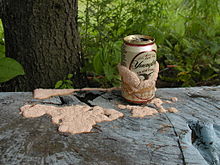
Back Slymvorme Afrikaans عفن غروي Arabic Слізевікі Byelorussian Sluzaste plijesni BS Fong mucilaginós Catalan Schleimpilze German Slime mold English Moho mucilaginoso Spanish Onddo lirdingatsu Basque کپک مخاطی Persian






Slime moulds, or slime molds, are forms of life which live on the rainforest floor, and many other parts of the world. They slither over ground and fallen tree trunks in search of food. They scatter spores, like plants, which grow into new slime moulds.
They are a way of life, or life-form, which has evolved a number of times. Because they are not a monophyletic group, they are put into several different phyla. They have some features of fungi and some features of protozoa.[1] This was discussed by Anton de Bary in 1858.[2]
They spend part of their lives as isolated cells, but come together when a chemical signal is released. Then together, they form a multicellular organism which reproduces and makes spores. So they are both single-celled and multicellular. That is not all: the multicellular form loses its cell walls, and becomes a syncytium. This is an organism with many nuclei, but few or no cell walls.
The single cells are amoeboid (amoeba-like) and haploid (one set of chromosomes, like our gametes). The multi-nuclear stage is called a plasmodium. It is diploid, formed from fusions between pairs of amoeboid cells. It gains nutrition by phagocytosing bacteria and food particles.
As the food supply fades, the plasmodium makes haploid cells by meiosis, and they form the basis of spores. The spores are kept and then distributed from a structure like a sporangium. This life-cycle is typical of the main group called Mycetozoa.